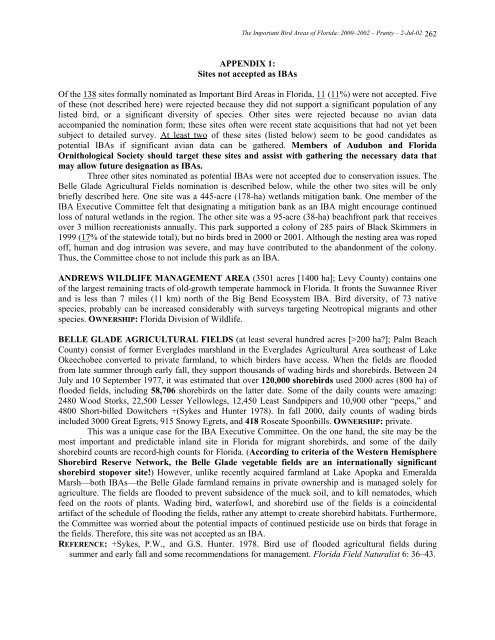The Important Bird Areas of Florida - National Audubon Society
The Important Bird Areas of Florida - National Audubon Society
The Important Bird Areas of Florida - National Audubon Society
You also want an ePaper? Increase the reach of your titles
YUMPU automatically turns print PDFs into web optimized ePapers that Google loves.
<strong>The</strong> <strong>Important</strong> <strong>Bird</strong> <strong>Areas</strong> <strong>of</strong> <strong>Florida</strong>: 2000–2002 – Pranty – 2-Jul-02 262APPENDIX 1:Sites not accepted as IBAsOf the 138 sites formally nominated as <strong>Important</strong> <strong>Bird</strong> <strong>Areas</strong> in <strong>Florida</strong>, 11 (11%) were not accepted. Five<strong>of</strong> these (not described here) were rejected because they did not support a significant population <strong>of</strong> anylisted bird, or a significant diversity <strong>of</strong> species. Other sites were rejected because no avian dataaccompanied the nomination form; these sites <strong>of</strong>ten were recent state acquisitions that had not yet beensubject to detailed survey. At least two <strong>of</strong> these sites (listed below) seem to be good candidates aspotential IBAs if significant avian data can be gathered. Members <strong>of</strong> <strong>Audubon</strong> and <strong>Florida</strong>Ornithological <strong>Society</strong> should target these sites and assist with gathering the necessary data thatmay allow future designation as IBAs.Three other sites nominated as potential IBAs were not accepted due to conservation issues. <strong>The</strong>Belle Glade Agricultural Fields nomination is described below, while the other two sites will be onlybriefly described here. One site was a 445-acre (178-ha) wetlands mitigation bank. One member <strong>of</strong> theIBA Executive Committee felt that designating a mitigation bank as an IBA might encourage continuedloss <strong>of</strong> natural wetlands in the region. <strong>The</strong> other site was a 95-acre (38-ha) beachfront park that receivesover 3 million recreationists annually. This park supported a colony <strong>of</strong> 285 pairs <strong>of</strong> Black Skimmers in1999 (17% <strong>of</strong> the statewide total), but no birds bred in 2000 or 2001. Although the nesting area was roped<strong>of</strong>f, human and dog intrusion was severe, and may have contributed to the abandonment <strong>of</strong> the colony.Thus, the Committee chose to not include this park as an IBA.ANDREWS WILDLIFE MANAGEMENT AREA (3501 acres [1400 ha]; Levy County) contains one<strong>of</strong> the largest remaining tracts <strong>of</strong> old-growth temperate hammock in <strong>Florida</strong>. It fronts the Suwannee Riverand is less than 7 miles (11 km) north <strong>of</strong> the Big Bend Ecosystem IBA. <strong>Bird</strong> diversity, <strong>of</strong> 73 nativespecies, probably can be increased considerably with surveys targeting Neotropical migrants and otherspecies. OWNERSHIP: <strong>Florida</strong> Division <strong>of</strong> Wildlife.BELLE GLADE AGRICULTURAL FIELDS (at least several hundred acres [>200 ha?]; Palm BeachCounty) consist <strong>of</strong> former Everglades marshland in the Everglades Agricultural Area southeast <strong>of</strong> LakeOkeechobee converted to private farmland, to which birders have access. When the fields are floodedfrom late summer through early fall, they support thousands <strong>of</strong> wading birds and shorebirds. Between 24July and 10 September 1977, it was estimated that over 120,000 shorebirds used 2000 acres (800 ha) <strong>of</strong>flooded fields, including 58,706 shorebirds on the latter date. Some <strong>of</strong> the daily counts were amazing:2480 Wood Storks, 22,500 Lesser Yellowlegs, 12,450 Least Sandpipers and 10,900 other “peeps,” and4800 Short-billed Dowitchers +(Sykes and Hunter 1978). In fall 2000, daily counts <strong>of</strong> wading birdsincluded 3000 Great Egrets, 915 Snowy Egrets, and 418 Roseate Spoonbills. OWNERSHIP: private.This was a unique case for the IBA Executive Committee. On the one hand, the site may be themost important and predictable inland site in <strong>Florida</strong> for migrant shorebirds, and some <strong>of</strong> the dailyshorebird counts are record-high counts for <strong>Florida</strong>. (According to criteria <strong>of</strong> the Western HemisphereShorebird Reserve Network, the Belle Glade vegetable fields are an internationally significantshorebird stopover site!) However, unlike recently acquired farmland at Lake Apopka and EmeraldaMarsh—both IBAs—the Belle Glade farmland remains in private ownership and is managed solely foragriculture. <strong>The</strong> fields are flooded to prevent subsidence <strong>of</strong> the muck soil, and to kill nematodes, whichfeed on the roots <strong>of</strong> plants. Wading bird, waterfowl, and shorebird use <strong>of</strong> the fields is a coincidentalartifact <strong>of</strong> the schedule <strong>of</strong> flooding the fields, rather any attempt to create shorebird habitats. Furthermore,the Committee was worried about the potential impacts <strong>of</strong> continued pesticide use on birds that forage inthe fields. <strong>The</strong>refore, this site was not accepted as an IBA.REFERENCE: +Sykes, P.W., and G.S. Hunter. 1978. <strong>Bird</strong> use <strong>of</strong> flooded agricultural fields duringsummer and early fall and some recommendations for management. <strong>Florida</strong> Field Naturalist 6: 36–43.
















